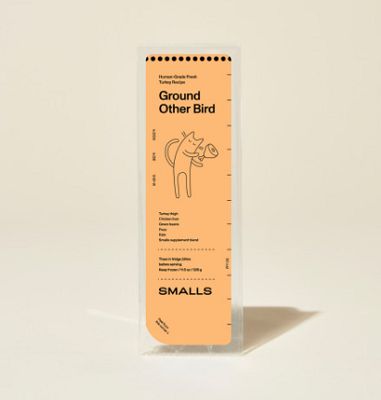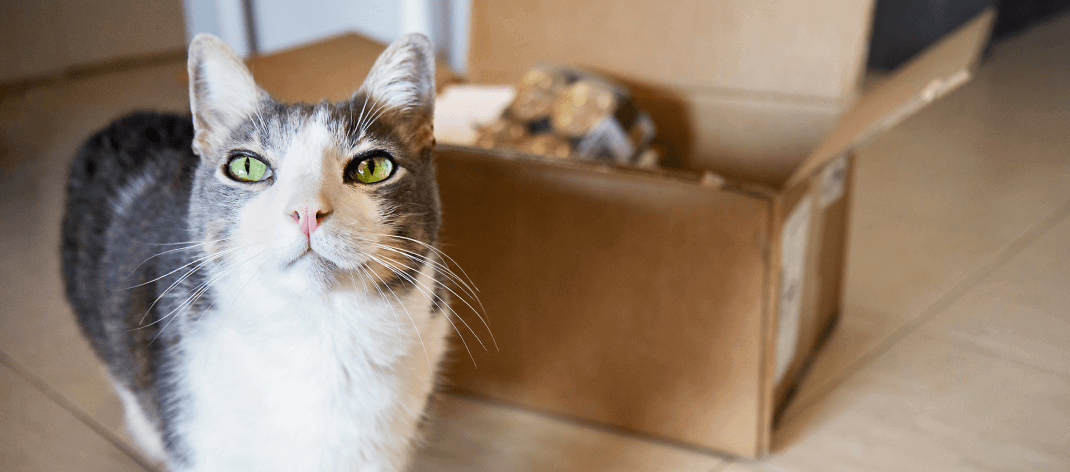
At a Glance: Best Cat Food to Buy in 2025
After testing and reviewing over 200 cat food brands and hundreds more recipes, we know which brands and products are worthy of your cat’s bowl - and which ones aren’t. With taste, nutrition, and quality ingredients top of mind, here are the 9 best cat foods you can give your cat.





Smalls Ground Bird Fresh Cat Food
- Fresh food made with human-grade ingredients
- Single source of high-quality animal protein
- Very low in carbohydrates
- Made In: United States
- Guaranteed Protein: 13%
- Age Range: All Life Stages
- Calories Per Ounce: 40
- Calories Per Pound: 640
- Typical Cost Per Day: $4.00 per day
Smalls is a fresh cat food delivery service that uses human-grade ingredients, including premium proteins like chicken, turkey, beef, and fish. Choose from minced-style recipes or classic pâté to provide your cat with protein-rich, low-carb cat food that’s formulated for cats of all life stages.
The brand’s Fresh Ground Bird recipe features chicken and chicken liver as its top two ingredients. With green beans, kale, and dandelion greens as the only plant ingredients, this formula is very low in carbohydrates. It offers plenty of animal-sourced omega-3 fatty acids and is rich in hydrating moisture.
When you place your first order, you’ll receive a sampler pack catered to your cat’s protein preferences and dietary requirements. You can adjust your meal plan, pause deliveries, or cancel your subscription through the customer portal, via email, or by text. Every Smalls subscription includes free treats for life.
Sample buyer review...
“I have been using Smalls for a couple of months now on my 5-month-old kitten (Milo). He absolutely loves their food! I began with the trial box to find out what he likes/dislikes. He seems to love the Bird and Other-Bird. I love how Smalls gives you the option to choose the quantity of each type of meal and the flexibility without maxing out one type.”
What We Liked:
- Fresh food made with human-grade ingredients
- Single source of high-quality animal protein
- Rich source of hydrating moisture
What We Didn’t Like:
- Only available as a subscription plan
- Support by text and email only
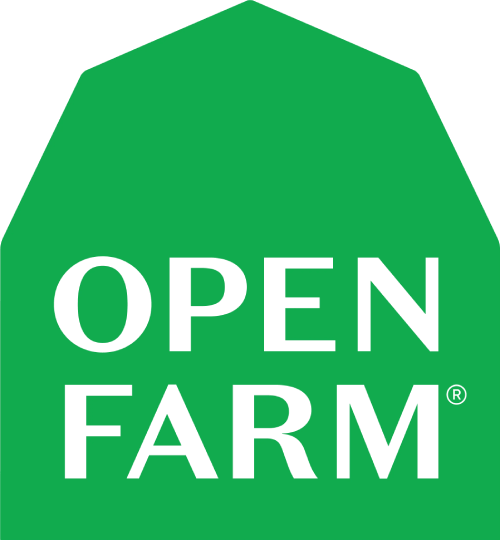
Open Farm RawMix Dry Food
- Open Farm offers superior transparency compared to other brands
- Rich in animal-derived protein
- Seems to be made from high-quality ingredients
- Made In: United States
- Guaranteed Protein: 38%
- Age Range: All Life Stages
- Calories Per Ounce: 106
- Calories Per Pound: 1696
- Typical Cost Per Day: $0.90 per day
Open Farm is a newer pet food brand that’s earned our respect with excellent transparency and end-to-end quality, including detailed information on ingredient sourcing, partnerships with ethical suppliers, and typical analyses available for each recipe.
What distinguishes Open Farm’s RawMix from other dry foods is its inclusion of freeze-dried raw ingredients. The line’s Grain-Free Open Prairie recipe features nutrient-packed kibble coated in a blend of bone broth and freeze-dried raw meat.
While this formula is carbohydrate-heavy, we like that it contains more animal-derived protein than other Open Farm formulas. This recipe derives its animal protein from chicken, turkey, and menhaden fish meal. Additional protein comes from chicken liver, chicken neck, and whitefish meal. This recipe is fairly low in fat, so it isn’t as calorie-dense as others on this list.
Sample buyer review...
"I used Open Farm when I used to feed my cats kibble. I personally really love their sustainability model and the fact that every ingredient is listed and comes with a source. It makes me feel better about what I'm feeding my cats. It's a very healthy food too! It's not high on carbs, but every kibble is. It has a fairly high protein content too. My cats were always eager to eat it as well."
What We Liked:
- Open Farm offers superior transparency compared to other brands
- Rich in animal-derived protein
- Seems to be made from high-quality ingredients
What We Didn’t Like:
- Fairly pricey option
- Main sources of added fat are plant-based: coconut oil and sunflower oil
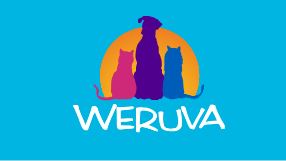
BFF Tuna & Pumpkin Valentine Dinner in Gravy Canned Cat Food
- Primarily made from tuna, a readily-digested animal ingredient
- Doesn’t contain any animal by-products or low-value animal ingredients
- Free of artificial colors, flavors, and preservatives that might harm your cat over time
- Made In: Thailand
- Guaranteed Protein: 12%
- Age Range: Adult
- Calories Per Ounce: 24
- Calories Per Pound: 384
- Typical Cost Per Day: $2.37 per day
If you’re on a very tight budget, the BFF Tuna & Pumpkin Valentine Dinner in Gravy Canned Cat Food recipe above is a decent option. Should you have a little more wiggle room with your finances, however, you can give your cat a significant upgrade on quality while keeping your daily feeding cost around $3.08 per day .
This recipe contains a mix of minced tuna and pumpkin. It’s a chunky stew thickened with potato starch, stabilized with xanthan gum, and made nutritionally complete with all the vitamins, minerals, and amino acids that adult cats need to thrive.
With a hearty combination of pumpkin and tuna and a chunky texture cats love, this food is a delicious option that even picky eaters seem to love. In terms of macronutrient distribution, this is one of the better products in the OMG line. Its carbohydrate content is a little higher than we’d like, but 12% carbohydrates is better than most foods on the market. Though this food doesn’t contain any added oils or fats, the natural richness of pumpkin and tuna make it one of BFF’s fattier recipes. It’s over 12% fat on a dry matter basis.
Sample buyer review...
"Our old guy is a VERY picky eater. He doesn’t have many teeth left:-( so can only eat soft food. He usually picks at it, eats a bit and leaves the rest. I have been on a quest to find food he will eat entirely. Well, not only does he CLEAN HIS BOWL (OMG) – he is begging for more immediately! I got the food 2 days ago and I already need to place another order. Wow."
What We Liked:
- Primarily made from tuna, a readily-digested animal ingredient
- Doesn’t contain any animal by-products or low-value animal ingredients
- Free of artificial colors, flavors, and preservatives that might harm your cat over time
- Low carbohydrate content
- Low calorie content makes it a good option for cats who need to lose weight
- A moisture-rich, hydrating food
What We Didn’t Like:
- Fish-based foods aren’t ideal for long-term feeding
- Low in animal-sourced fat

Smalls Fresh Ground Other Bird
- Fresh food made with human-grade ingredients
- Single source of high-quality animal protein
- Rich source of hydrating moisture
- Made In: United States
- Guaranteed Protein: 14.5%
- Age Range: All Life Stages
- Calories Per Ounce: 40
- Calories Per Pound: 640
- Typical Cost Per Day: $4.00 per day
Smalls is a fresh cat food delivery service that uses human-grade ingredients, including premium proteins like chicken, turkey, beef, and fish. Choose from minced-style recipes or classic pâté to provide your cat with protein-rich, low-carb cat food that’s formulated for cats of all life stages.
The brand’s Fresh Ground Bird recipe features chicken and chicken liver as its top two ingredients. With green beans, kale, and dandelion greens as the only plant ingredients, this formula is very low in carbohydrates. It offers plenty of animal-sourced omega-3 fatty acids and is rich in hydrating moisture.
When you place your first order, you’ll receive a sampler pack catered to your cat’s protein preferences and dietary requirements. You can adjust your meal plan, pause deliveries, or cancel your subscription through the customer portal, via email, or by text. Every Smalls subscription includes free treats for life.
Sample buyer review...
We have overall really, really loved Smalls. The quality is outstanding and we have seen several health benefits for our girls - most noticeably their coats, and the smell of the litter box is much much less! Deliveries have always been good, never any issues there.
What We Liked:
- Made with a single source of animal protein
- Very low carbohydrate content
- Good source of hydrating moisture
- Multiple protein and texture options
What We Didn’t Like:
- Only available as a subscription plan
- No phone support (text and email only)

Open Farm Harvest Chicken Rustic Blend Wet Cat Food
- Packed with premium animal protein
- Low in carbohydrates
- No artificial additives or preservatives
- Made In: United States
- Guaranteed Protein: 8.10%
- Age Range: All Life Stages
- Calories Per Ounce: 30
- Calories Per Pound: 480
- Typical Cost Per Day: $3.60 per day
Though relatively new to the pet food industry, Open Farm has quickly become popular—especially among eco-conscious consumers. Open Farm pet food is made from responsibly sourced, human-grade ingredients. The brand’s sourcing policy emphasizes humanely raised poultry and meat, as well as sustainably-harvested wild-caught fish. All their fruits and vegetables are non-GMO.
This chicken-based recipe appears to rely primarily on animal-sourced protein, though it’s hard to say how much beans and legumes like garbanzo beans and lentils contribute to the total crude protein content. As a whole, the food is moderately high in protein, measured at nearly 39% on a dry matter basis, and fairly low in carbohydrates at under 20%.
The food’s dry matter fat content is almost equal to the protein content. At 30 calories per ounce, this recipe is fairly calorie-dense, so follow the feeding recommendations carefully if your cat is prone to weight gain. Overall, if you prefer to support brands that are conscious of their impact on the environment, Open Farm might be a good pick.
What We Liked:
- Made from responsibly-humanely raised chicken
- Animal protein sources are the food’s primary ingredients
- Free of potentially-harmful artificial colors, flavors, and preservatives
- Cats tend to love the taste of this food
What We Didn’t Like:
- Contains some beans and legumes

Caru Classic Turkey Stew Grain-Free Wet Food
- Made with a single source of animal protein
- Rich in hydrating moisture
- Cats seem to like the flavor and texture
- Made In: United States
- Guaranteed Protein: 9%
- Age Range: All Life Stages
- Calories Per Ounce: 28
- Calories Per Pound: 448
- Typical Cost Per Day: $3.60 per day
Cats can be finicky in their food preferences; some prefer certain types, flavors, and textures. If you’re having trouble getting your cat to eat traditional canned or dry cat foods, this stew-style recipe from Caru might pique their interest. It also doesn’t hurt that the dry matter carbohydrate content of this recipe is very low.
Caru’s grain-free Turkey Stew is made with a single source of animal protein: turkey muscle meat. The food is gently cooked in turkey bone broth for flavor and moisture, so it supports your cat’s hydration as well. That said, some reviewers comment that the food contains too much liquid and verges on soupy. When it comes to the texture of cat food, your cat has the final say.
This wet cat food is fairly expensive, costing over $3.50 a day to feed the average 10-pound cat. It does, however, come in resealable cardboard cartons rather than cans, so it’s easy to store the leftovers if you prefer to mix it with another food.
Sample buyer review...
"I bought this for my cat after she had dental surgery (6 teeth removed) because I figured she’d like to have something soft to eat. So I gave her a small bowl of it, then started using it to soften her dry food. She goes crazy for it! I bought some of the less expensive, regular chicken broth for cats and dogs, too, but she didn’t seem to like it. I’m giving her this stuff as a treat now."
What We Liked:
- Made with a single source of animal protein
- Rich in hydrating moisture
- Cats seem to like the flavor and texture
- Very low carbohydrate content
What We Didn’t Like:
- Fairly expensive
- Cardboard cartons can be tricky to open
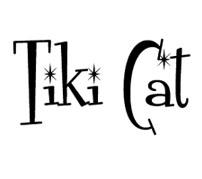
Tiki Cat Puka Puka Luau Succulent Chicken
- Rich in nourishing animal protein
- High moisture content helps to flush the urinary tract
- Low ash shouldn’t contribute to crystal formation
- Made In: Thailand
- Guaranteed Protein: 16%
- Age Range: Adult
- Calories Per Ounce: 25
- Calories Per Pound: 400
- Typical Cost Per Day: $5.00 per day
If you’re looking for a healthy way for your cat to lose weight, the right food can help. Consider Tiki Cat’s Puka Puka Luau Wet Food. The protein content of the brand’s Succulent Chicken Recipe is incredibly high at about 80% measured as dry matter, and there is no significant carbohydrate content. It’s definitely worth noting the very low calorie and fat content of this food.
This recipe from Tiki Cat is low in ash, which will help lower the risk of urinary crystal formation. This recipe also has enough moisture to flush the urinary tract and has a species-appropriate pH that won’t cause crystal formation.
We’ll admit, this food is very expensive to feed as a staple diet. However, the cost may be less than a prescription diet formulated to support urinary tract health.
Sample buyer review...
"As in transitioning off kitten food and into adult food, I was worried that my cats wouldn’t like new kibble but they didn’t hesitate to eat this. Helps with their digestive problems and still comes in small bite size pieces. A little on the pricier side but cheaper than any of the other grain free options I’ve seen."
What We Liked:
- Rich in nourishing animal protein
- High moisture content helps to flush the urinary tract
- Low ash shouldn’t contribute to crystal formation
- Species-appropriate pH helps keep things in balance
What We Didn’t Like:
- Contains sunflower oil instead of species-appropriate animal fat
- Low fat content isn’t right for every cat
- Very low in fiber

Smalls Fresh Smooth Fish Recipe
- Rich in animal-sourced protein
- Low carbohydrate content
- Short list of easily digestible main ingredients
- Made In: United States
- Guaranteed Protein: 15%
- Age Range: All Life Stages
- Calories Per Ounce: 36
- Calories Per Pound: 576
- Typical Cost Per Day: $4.00 per day
Featuring salmon and cod as the main ingredients, this fish-based fresh cat food has a smooth, pate texture. Measured as dry matter, the food contains over 62% protein and around 20% fat. Combined with the recipe’s low carbohydrate content, it’s another carnivore-appropriate formula.
Not only is this recipe easily digestible for most cats, but the salmon, cod, and cod liver oil all provide animal-sourced omega-3 fatty acids. These fatty acids may help keep your cat’s coat shiny and soft.
Though packed with animal-sourced protein, this recipe is much less calorie-dense than the previous two formulas. As such, it may be an appropriate choice for overweight cats who need to shed a few pounds. To maintain or gain weight, however, your cat may need larger portions of this food which could increase your monthly subscription cost.
Sample buyer review...
"Excellent product and customer service. I have a fur baby with a picky palate, sensitive stomach, and struggles with drinking water. He loves Smalls fish and so does his stomach. Grateful for the extra hydration it provides."
What We Liked:
- Short list of easily digestible main ingredients
- Good source of hydrating moisture
- Rich in animal-sourced omega-3 fatty acids
What We Didn’t Like:
- Low calorie content may necessitate larger portions
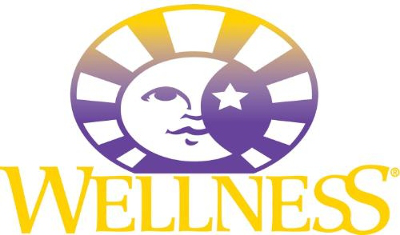
Wellness CORE Kitten Turkey & Chicken Liver Recipe Classic Pate
- Ultra-soft pâté texture is easy for kittens to eat
- Rich in protein and calories
- Hydrating canned food
- Made In: United States
- Guaranteed Protein: 12%
- Age Range: Kitten
- Calories Per Ounce: 36
- Calories Per Pound: 576
- Typical Cost Per Day: $3.50 per day
Wellness CORE’s Chicken, Turkey, and Chicken Liver Recipe has everything we look for in kitten food. It’s loaded with nourishing animal protein from turkey, chicken liver, chicken muscle meat, and chicken meal. The dry matter carbohydrate content is below 10%, and it’s a hydrating source of moisture.
While menhaden fish oil is the primary added fat in this recipe, herring also supplies animal-sourced omega-3 fatty acids. Both are strong sources of DHA, which contributes to brain and eye development in kittens. Omega-3s also play an important role in supporting healthy skin and coats in cats.
This recipe doesn’t contain any grains or starchy beans, peas, or legumes.
At over 50% crude protein measured as dry matter, this recipe is formulated to support the development of lean mass. It’s also calorie-dense enough to fuel your kitten’s growth at about 36 calories per ounce.
Sample buyer review...
"Wellness makes great cat food. The main ingredient in their food is meat. Cats are obligate carnivores. They need meat, and wellness provides them with exactly what they need."
What We Liked:
- Ultra-soft pâté texture is easy for kittens to eat
- Rich in protein and calories
- Hydrating canned food
- Supplemented with fish oil as a species-appropriate source of DHA
What We Didn’t Like:
- Can be quite expensive when feeding a hungry kitten
Top Cat Food – Comparison
| Product Name | Primary Protein | Age Range | Guaranteed Protein | Calories Per Ounce | Calories Per Pound | Cost Per Day* |
 Smalls Ground Bird Fresh Cat Food
Smalls Ground Bird Fresh Cat Food
|
Chicken | All Life Stages | 13% | 40 | 640 | $4.00 per day |
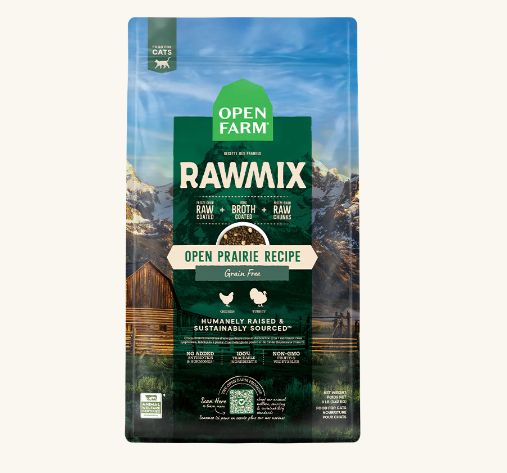 Open Farm RawMix Dry Food
Open Farm RawMix Dry Food
|
Chicken | All Life Stages | 38% | 106 | 1696 | $0.90 per day |
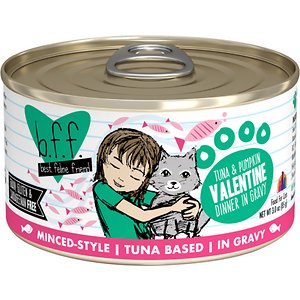 BFF Tuna & Pumpkin Valentine Dinner in Gravy Canned Cat Food
BFF Tuna & Pumpkin Valentine Dinner in Gravy Canned Cat Food
|
Tuna | Adult | 12% | 24 | 384 | $2.37 per day |
 Smalls Fresh Ground Other Bird
Smalls Fresh Ground Other Bird
|
Turkey | All Life Stages | 14.5% | 40 | 640 | $4.00 per day |
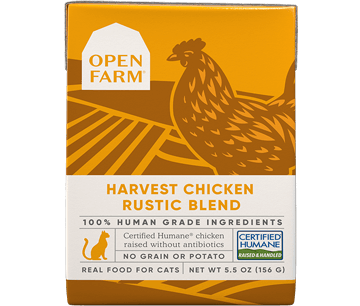 Open Farm Harvest Chicken Rustic Blend Wet Cat Food
Open Farm Harvest Chicken Rustic Blend Wet Cat Food
|
Chicken | All Life Stages | 8.10% | 30 | 480 | $3.60 per day |
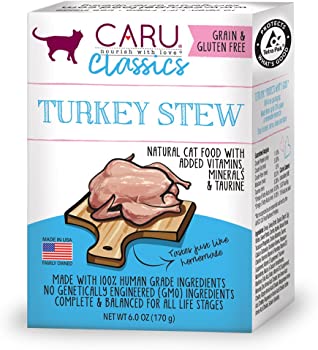 Caru Classic Turkey Stew Grain-Free Wet Food
Caru Classic Turkey Stew Grain-Free Wet Food
|
Turkey | All Life Stages | 9% | 28 | 448 | $3.60 per day |
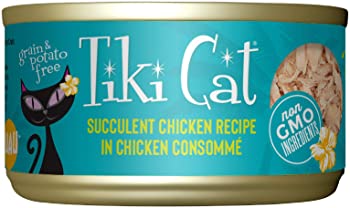 Tiki Cat Puka Puka Luau Succulent Chicken
Tiki Cat Puka Puka Luau Succulent Chicken
|
Chicken | Adult | 16% | 25 | 400 | $5.00 per day |
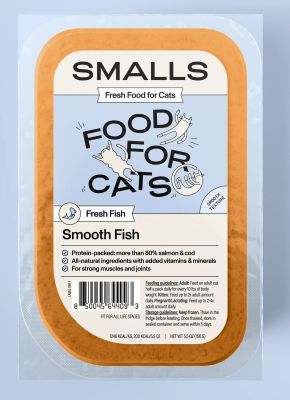 Smalls Fresh Smooth Fish Recipe
Smalls Fresh Smooth Fish Recipe
|
Salmon | All Life Stages | 15% | 36 | 576 | $4.00 per day |
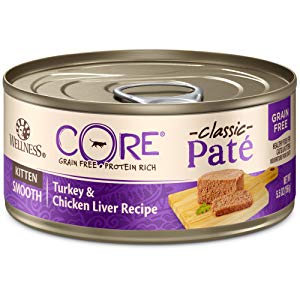 Wellness CORE Kitten Turkey & Chicken Liver Recipe Classic Pate
Wellness CORE Kitten Turkey & Chicken Liver Recipe Classic Pate
|
Turkey | Kitten | 12% | 36 | 576 | $3.50 per day |
Why Trust Cats.com
Over the past years, the Cats.com team has tested and reviewed hundreds of cat food brands and recipes. In choosing products to test, we prioritized meat-centric formulas for cats in various life stages with different needs and preferences. All products were purchased at full retail price and evaluated in-depth. Our cats provided input on the foods’ flavor and general appeal while we analyzed the product information to determine its nutritional adequacy. We also researched the brands to assess their trustworthiness and rate of customer satisfaction.
Our team of veterinary experts provides additional informative support as well as their professional opinion on what makes a great cat food.
Our Veterinary Advisors:
- Dr. Sarah Wooten, DVM, CVJ
- Dr. Chris Vanderhoof, DVM, MPH
- Dr. Sarah Reidenbach, DVM
- Dr. Chyrle Bonk, DVM
- Dr. Jamie Whittenburg, DVM
- Dr. Albert Ahn, DVM
- Dr. Elizabeth Youens, DVM
Summary
Whether wet, dry, raw, or freshly cooked, the best cat food honors your cat’s needs as an obligate carnivore. It’s rich in animal-sourced protein, has the right amount of fatty acids, and doesn’t spike your cat’s blood sugar with excessive carbohydrates.
After researching feline nutrition and reviewing all kinds of cat foods, we learned which brands and products are worthy of your cat’s bowl—and which ones aren’t.
With taste, nutrition, and quality ingredients always top of mind, we have chosen Smalls Ground Bird Fresh Cat Food as the best cat food.
Frequently Asked Questions
What is the best dry cat food?
The best dry cat food is rich in animal-derived protein, low in carbohydrate content, and made from high-quality ingredients. Look for expert-formulated recipes that were made with carnivores in mind.
What is the best wet cat food?
The best wet cat food is rich in animal-derived protein with low carbohydrate content. It’s made from high-quality ingredients and doesn’t contain a lot of artificial additives, thickeners, and other ingredients that may harm your cat over time.
Is dry or wet food best for cats?
Because it’s more hydrating and typically lower in carbohydrates, wet food is best for cats. A dry diet is convenient, but it is generally higher in starch and may not provide the moisture your cat needs.
Is grain-free cat food best for cats?
In general, cats don’t need to avoid grains. Grain allergies and sensitivities are rare, and grain-free foods are often high in carbohydrates and plant matter. Instead, we recommend looking for a meat-based diet that closely reflects your cat’s evolutionary needs.










